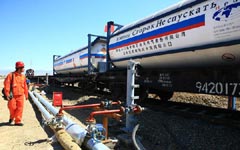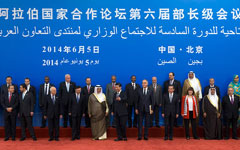The history of the Silk Road dates back over 2,000 years - an ancient trade route from eastern China to Constantinople in Turkey with links to Italy and France.
The trade of silk, chinaware, spices and leather, among many goods, as well as cultural communication and the movement of labor, promoted a strong and rich economic zone along the route between 100 BC and the 10th century.
The new Silk Road strategy was initially proposed by Xi in September and consists of developing economic ties in areas along the ancient land and maritime silk routes, encompassing 40 countries and 3 billion people.
The initiative, in conjunction with the EU's strategic goal of establishing a free trade zone from Lisbon in Portugal to Vladivostok in Russia, has the potential to create one of the strongest economic zones in the world.
References to the Silk Road in Chinese government plans have similarities to those developed by former US secretary of state Hilary Clinton in 2011, which targeted a revitalization of Central Asia and South Asia via Afghanistan, with a proposed pipeline from Turkmenistan through Afghanistan and Pakistan to India.
However, political divisions in these countries meant the US initiative failed to materialize.
 |
 |
In contrast, the Chinese Silk Road strategy seems to have made significant progress in securing access to energy fields in Kazakhstan, Kyrgyzstan, Turkmenistan and Uzbekistan, with numerous commercial and investment deals already made or being discussed.
By doing this, China has outflanked the United States and Russia in establishing links with former republics of the Soviet bloc.
Both the Chinese and European governments are engaged in profound structural reforms, some of which are highly complementary.
The Chinese government has four key objectives, in which collaboration with Europe is highlighted as potentially fruitful.
- Increased domestic consumption: By placing increased weight on Chinese consumption, the easing of trade barriers would reduce the price of European products, which would match the new needs of Chinese consumers.
- Services cooperation: Consumption could also be boosted by providing the peace of mind of better social protection, an area in which European countries have a wealth of experience in what works and what doesn't. Cooperation in healthcare provision, financial products and services, education and R&D, and leisure are particularly promising.
- Promoting the yuan as a reserve currency: The setting up of yuan-clearing systems in the United Kingdom, Germany and France and the establishment of swap arrangements with the European Central Bank are crucial to the future internationalization of the yuan.
- Sustainable urbanization: Developing a sustainable model of urbanization is what has driven modern China. But now rapid development needs to be backed up with an increased supply of clean energy, better organization of the carbon market, security of its nuclear energy industry, and the reduction of nuclear, civil and industrial waste - all areas in which Europe is highly competitive.
In Europe, meanwhile, austerity continues, highlighting an urgent need to find commercial outlets and new markets to offset weaknesses in domestic demand.
Access to China's domestic market could be offered in exchange for collaboration in China's domains of interest.
China and Europe have historically represented an alternative to the influence of Russia and the US, the super powers of the Cold War, and this counterbalancing strategy now targets the longer-term benefits of collaboration.
